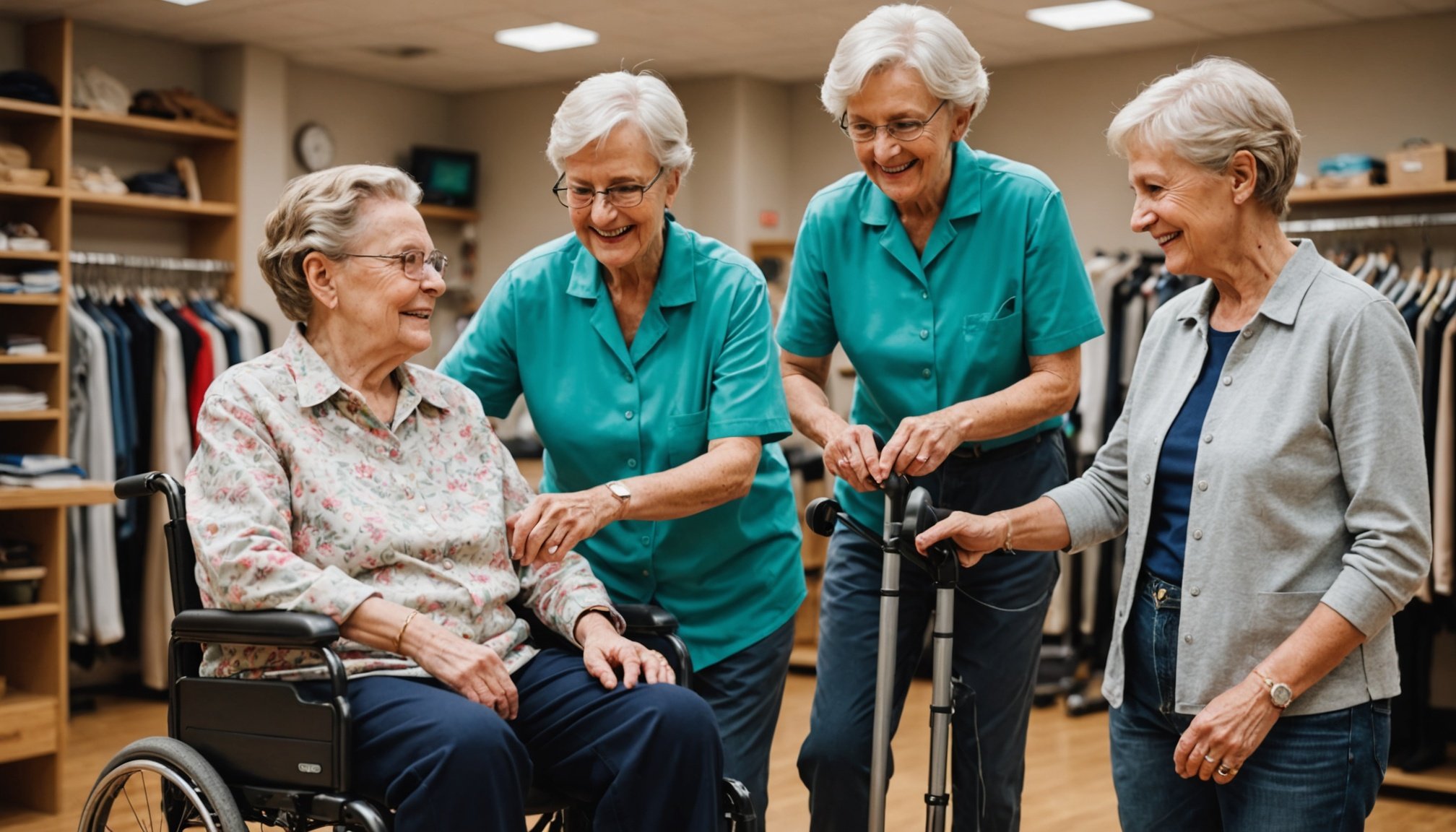Understanding Adaptive Clothing for Seniors
Adaptive clothing is more than just fashion; it meets senior clothing needs by offering functional garments that accommodate the unique challenges elderly individuals face. Traditional clothing often falls short, demanding dexterity, flexibility, and strength that can diminish with age. This can lead to feelings of frustration and hinder everyday tasks like dressing.
By addressing these obstacles, adaptive clothing plays a crucial role in enhancing independence and dignity. Such clothing is designed with the senior’s comfort and convenience in mind, incorporating features like open-back tops that require minimal shoulder mobility, or magnetic closures that combat difficulty with buttons.
Also to see : Must-have mobility scooter attributes for seniors: key features to enhance your freedom
Some seniors may face specific challenges with traditional clothing, including issues related to arthritis, limited mobility, or using assistive devices like wheelchairs. The innovative design of adaptive clothing, therefore, ensures that seniors maintain ease and autonomy in their daily routine, contributing to their overall well-being.
The significance of adaptive clothing extends beyond practicality. It empowers seniors to dress independently, thereby preserving their dignity and quality of life while enhancing their independence. As such, adaptive clothing emerges as a thoughtful solution for those navigating the complexities of aging.
In parallel : Transforming senior safety: the essential guide to selecting footwear that minimizes fall risks
Key Factors to Consider in Fabric Choices
Comfort and practicality are crucial when selecting clothes for seniors. Breathable materials, like cotton and bamboo, are excellent choices as they keep skin cool and reduce sweat, thus enhancing comfort. These breathable fabrics not only regulate temperature but also prevent skin irritations, which are common among older adults. Moisture-wicking fabrics are particularly beneficial in managing perspiration, providing a fresh and dry feel all day.
Another critical element is the stretchability of fabric. Stretchable fabrics offer more freedom of movement and accommodate simple body changes, ensuring the clothing remains comfortable and well-fitting over time. Fabrics like spandex blends or knits adapt to the body’s shape, offering ease of wear, especially for those with reduced mobility.
Finally, easy-care fabrics are indispensable to minimise the hassle of maintenance for seniors or their caregivers. Fabrics like polyester blends resist wrinkles and stains, requiring less ironing and special care. Choosing clothes made from these easily manageable materials can save time and effort while maintaining the wearer’s appearance. Each of these fabric considerations ensures that senior clothing is not just functional but also fits seamlessly into seniors’ lifestyles.
Ease of Wear and Accessibility
Adaptive clothing for seniors prioritizes ease of wear and accessibility through innovative design. This includes features tailored to simplify dressing, such as open-back designs and elastic waistbands. These features reduce the physical strain of dressing, especially beneficial for those with limited mobility or dexterity.
The choice of fastenings and closures is critical. Options like Velcro, snaps, and zippers are selected for their simplicity, making garments more accessible. Velcro, for instance, often replaces traditional buttons, providing not just ease but also a sense of autonomy as seniors manage dressing themselves.
For wheelchair users, adaptive garments accommodate specific needs. Pants with a higher rise at the back or seamless designs minimize discomfort. Adaptive tops often feature side openings, reducing the challenge of pulling garments over the head.
Selecting these clothing items necessitates considering each individual’s unique requirements. Tailoring garments with thoughtful closures can improve the independence of seniors, making dressing a seamless aspect of daily life. Enhancing accessibility in clothing designs empowers seniors, ensuring their attire is both functional and dignified. Ultimately, these thoughtfully designed garments offer a practical solution for those seeking to maintain autonomy.
Considerations for Medical Needs
Adaptive clothing can address various medical adaptations essential for seniors. Conditions like Parkinson’s, arthritis, or post-surgery recovery may necessitate special needs clothing. These garments simplify dressing and provide comfort amid health challenges.
Seniors using mobility aids such as walkers or wheelchairs benefit significantly from adapted designs. For instance, open-back tops and Velcro closures accommodate arm slings or casts without requiring excessive movement. Additionally, catheter access or monitoring devices are considered in the design of pants and tops; thoughtful modifications ensure ease without compromising medical needs.
When selecting these functional garments, healthcare consultation is advisable. Professionals can provide personalized recommendations, aiding in the choice of apparel that neither impedes medical devices nor causes discomfort during wear. Furthermore, it’s crucial to prioritize garments adaptable to health conditions, ensuring that they align with current therapeutic requirements or restrictions.
Medical experts highlight the importance of customized clothing solutions to foster comfort, security, and compliance with medical guidelines. This proactive approach significantly supports seniors in maintaining their wellness and dignity. Adaptive clothing thus plays a pivotal role in aiding seniors to live comfortably and with peace of mind, illustrating its specialized role beyond general use.
Budget Considerations
When it comes to purchasing adaptive clothing, understanding the balance between cost and durability is crucial. While initial pricing may vary, selecting pieces that offer value for money through quality materials and robust design is key. Affordable options abound if you know where to look; exploring various brands and partnership programs can unveil cost-effective clothing items that do not compromise on quality.
Durability directly affects long-term savings, making it wise to invest in clothing that withstands frequent use and laundering. This ensures that both the investment and the clothing item serve the senior well over time.
A practical approach to saving is to keep an eye out for sales and discounts, particularly those targeting adaptive clothing. Retailers often provide special deals, and signing up for newsletters can alert one to upcoming promotions or exclusive offers.
Moreover, engaging with affordable options does not solely focus on lower prices, but includes assessing the garment’s adaptability to evolving needs over time. By carefully considering each piece’s practical and economic benefits, families can ensure the clothing purchased not only meets immediate senior clothing needs but is also sensible from a financial standpoint.
Practical Tips for Selecting Adaptive Clothing
When selecting adaptive clothing, it’s essential to consider the unique needs of the senior individuals. Creating a checklist for caregivers can streamline the process and ensure that important features, such as fabric type and closure method, are not overlooked. This list should focus on the person’s specific challenges and style preferences to find the most suitable options.
Involving seniors themselves in the choice of garments can significantly enhance their satisfaction and sense of autonomy. Their input on colour, style, and comfort ensures that the clothing meets their personal tastes while still addressing their functional needs.
For caregivers and family members looking for reputable sources of adaptive clothing, several brands are noted for their quality and design. Exploring retailers with dedicated adaptive lines can provide both reassurance and choice in selecting the right pieces.
Valuable advice may include feeding comparisons for cost-effective clothing and durability. This ensures value for money over time, reducing the need for frequent replacements. While seeking out cheaper options, maintaining focus on value for money is crucial; each piece should effectively balance economy with the necessary functional adaptations to meet the senior clothing needs.
Case Studies and Testimonials
Understanding the impact of adaptive clothing is enriched by exploring real-life examples and testimonials. Seniors, who have integrated these specialized garments into their lives, often report enhanced independence and dignity. For instance, Emily, a caregiver, shared how her mother, who struggles with arthritis, regained autonomy and joy in daily routines by using clothing with Velcro closures and open-back designs. Such experiences underline the profound difference adaptive wear can make.
Furthermore, testimonials from caregivers highlight the reduction in caregiving stress. John, taking care of his uncle with Parkinson’s, noted that adaptive tops and elastic waistbands substantially minimized dressing challenges, restoring comfort and efficiency in their routine.
Industry experts emphasize trends like increasing use of breathable fabrics and smart designs, ensuring garments remain relevant and effective as needs evolve. The feedback from seniors and their families underscores the emotional and functional benefits, reinforcing that these clothing innovations meet vital needs beyond mere fashion. By sharing these stories, manufacturers are encouraged to continue developing versatile and practical clothing solutions, thus fostering a cycle of positive impact within the senior community.

